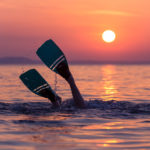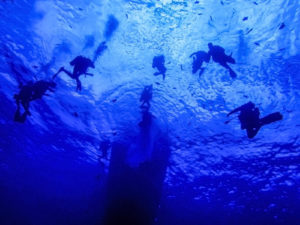Whether or not you've ever seen a shark on a dive and if you were "scared" are some of the most common questions scuba divers hear. To see a shark is an increasingly rare pleasure and privilege; the fishing industry kills an estimated 100 million sharks every year. Fins from up to 73 million animals become part of shark-fin soup. Overfishing has decimated some shark populations by up to 98 percent in the past 15 years, and the International Union for the Conservation of Nature considers almost 1/3 of pelagic shark species threatened.
And yet, the media still often wrongly maligns these magnificent animals. Misinformation, hyperbole and sensationalism are common currency, describing sharks as dangerous eating machines. In reality, leaving aside baited shark dives, they're reserved and cautious when near divers. The risk of harm from a shark encounter is statistically tiny, but these are apex predators and thusly, divers should treat them with respect.
If you're lucky enough to dive with sharks you can minimize your risks by practicing safe behavior around sharks. Here are our top tips for safe and enjoyable interactions.
Choose a responsible dive operator and buddy
Not all dive centers and dive buddies are created equal. If you're diving somewhere with lots of potential shark encounters, choose a reputable and environmentally-focused dive operator. Investigate online. Look for positive reviews. Ask friends and colleagues who may have dived in the area.
Many operators adhere to strict best-practice codes to ensure the safety of environment, animals and the divers. Guides and divers should not aggravate or mistreat the shark during the encounter. Similarly, dive with a buddy you know and trust to behave well beneath the surface, both towards the animals and you.
Understand the environment
To have a successful shark encounter, first you must have a successful dive. Research and be comfortable with the dive environment. Be proficient with the dive's conditions, whether that's the water temperature, currents, visibility or equipment configuration.
Also, don't dive in an environment or location where a shark is likely to mistake you for prey. If you're diving in the center of a seal colony that's the main prey of local sharks, you're putting yourself at risk of being mistaken for a food source. Respect the environment and the shark's territory and choose an alternative site when appropriate.
Time your dive
Dawn and dusk are prime hunting time for many types of sharks. There is likely to be more shark activity on a dive, but, conversely, a greater potential risk as they search for prey at those times of the day. Similarly, try to avoid shallow murky water. Bull sharks, in particular, hunt in these conditions and, if the shark cannot see the diver clearly — and vice versa — the risk of an accidental shark attack increases.

Enter and exit quietly and respectfully
This may seem a strange tip in a sport where you can't even speak beneath the surface. However, creating minimal disruption to the shark's usual environment leaves you more likely to observe their natural behavior and reduces any potential risk to yourself. Enter the water gently. Use steps or a seated entry where possible, avoiding the usual crashing giant stride. If a giant stride is your only option, you can opt for a negative entry and immediately leave the surface.
In that vein, try to limit your time on the surface in general. Many predatory sharks feed on dead animals or animals in distress at the surface. Similarly, some sharks prey on animals that spend extended time at the surface, such as seals — hence the penchant some larger sharks have for surfers.
At the end of your dive try, when possible, to ascend and board the boat directly. Avoid long surface swims and don't make unnecessary noise or splashes.
Smooth and subtle beneath the waves
Move slowly and steadily beneath the surface. Relax your breathing and don't approach or, worse, chase the shark. This will likely startle the animal and may provoke a defensive reaction.
Many diving experts recommend staying close the reef wall or seabed to avoid leaving yourself exposed. This habit has two advantages. First, a shark cannot startle you by sneaking up behind you outside of your field of vision – many sharks are ambush predators. Second, this helps ensure that a current doesn't pull you out into the blue and separate you from the dive group.
Safety in numbers – but not too many
Dive in a group to ensure that there are always eyes not only looking for sharks but also monitoring the sharks' and divers' behavior. However, try not to dive in too large a group. Some sharks may perceive a large group of divers in close proximity as a single, large animal and a correspondingly greater threat. If you become separated from your buddy or group, rejoin your group — or any group — as soon as possible.
Subtle interaction
Consider yourself a respectful visitor to the shark's environment. This is not a zoo — although you should be respectful there too, should you choose to visit one. The idea is to blend into the reef wall or seabed and observe the shark with minimal disturbance. In addition to entering and leaving the water quietly, try not to wear items that will mark you out to the shark. While there's no definitive evidence that "yum-yum-yellow" wetsuit trim or fins attract sharks, it's nonetheless best to avoid brightly colored wetsuits and jewelry as they may mimic the flashing of brightly colored prey.
Also, never "eyeball" the shark or flash your camera in its face, as this may aggravate it. There have also been reports that the whining of a flash re-charging attracts the animals quite close. Dive guides sometimes crackle a plastic bottle underwater by crushing and twisting it to create vibrations but note that this can sometimes stimulate feeding behavior. Humming gently may also make sharks more inquisitive and likely to swim by.
Learn shark behavior
Do your homework. Research the behavior of sharks in your environment. Read reputable articles specific to the species. Speak with local experts and guides. Sharks generally move slowly and steadily, conserving energy. They are highly evolved, intelligent animals that will display warning signals if they feel threatened by a diver's presence. If the shark illustrates a sudden behavioral change, this is a warning. Dropped pectoral fins, a gaping mouth, an arched back and increased speed are all signs to move close to the reef wall or seabed and, potentially, abort the dive.
Don't forget the basics
Seeing a shark, or any other large pelagic animal, doesn't change the laws of physics. Don't let your camera distract you. Stay with your buddy. Keep a close eye on your gas consumption, no-decompression limits, depth and ascent rate. Keep your cool.
Diving with sharks is a wonderful, humbling and beautiful experience. If done correctly, you'll minimize the risk to yourself, your buddies and the environment and get the chance to observe these beautiful creatures respectfully at relatively close quarters.
The post Safe Behavior Around Sharks appeared first on Scuba Diver Life.
from Scuba Diver Life https://ift.tt/2E2dl2I


No comments:
Post a Comment